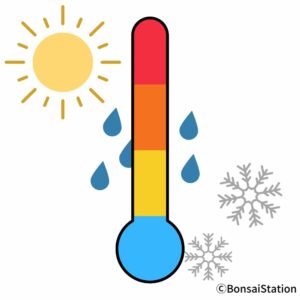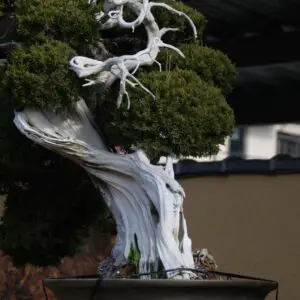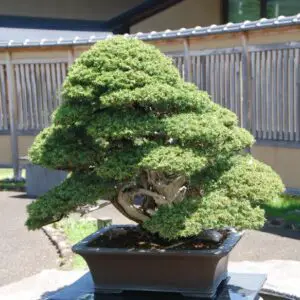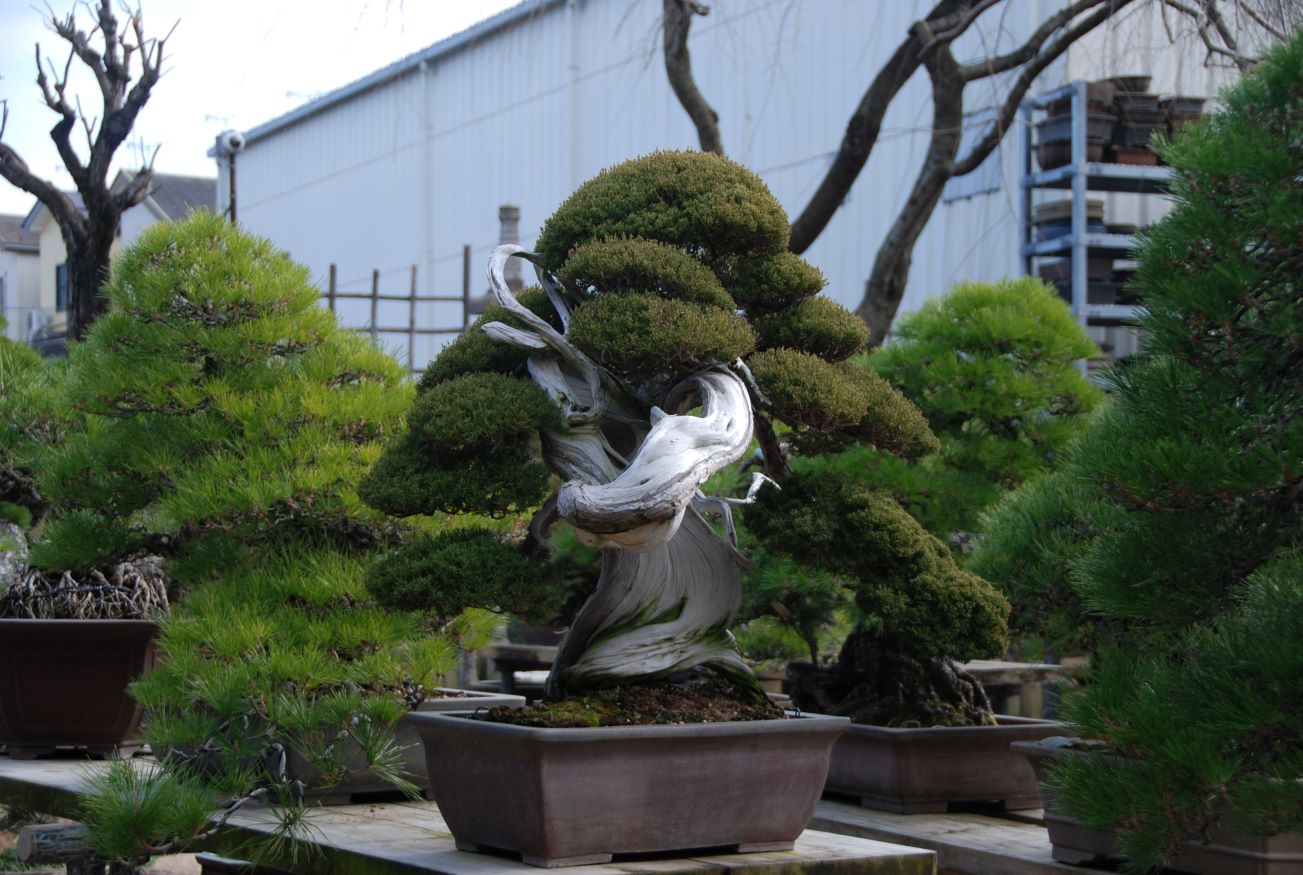Juniper bonsai trees can withstand temperatures from 14°F to 100°F (-10°C to 38°C), but their optimal temperature range for growth is between 60°F to 75°F (15°C to 24°C). Exposing them to temperatures outside this range can damage the tree.
Temperature requirements of juniper bonsai

Tolerable temperature range
Juniper bonsai trees are native to many regions around the world, including subarctic, temperate and even subtropical areas. As a result, they are able to tolerate a wide range of temperatures.
Most juniper bonsai trees can tolerate temperatures as low as 14°F (-10°C) and as high as 100°F (38°C).
Note that different varieties of juniper bonsai have different temperature requirements. Some varieties may be more cold-hardy, while others may be more heat-tolerant.
Optimal temperature range
Though they can tolerate a wide range of temperatures, juniper bonsai trees require a specific range of temperatures to thrive and flourish.
The optimal temperature range for juniper bonsai growth is between 60°F to 75°F (15°C to 24°C). Between this temperature range, the tree is able to photosynthesize effectively and take up nutrients and water from the soil.
Prolonged exposure to temperatures outside of the optimal range can stress and damage the tree, even if it is inside the tolerable range.
When juniper bonsai are exposed to extreme heat, they reduce photosynthesis and increase transpiration which results in less energy production and more water loss.
Extreme heat is bad for photosynthesis because it is a biochemical process that involves many enzyme-catalyzed reactions. Enzymes work best at certain temperatures where they have the highest activity and efficiency.
Trees transpire more under hot weather, just like we sweat more, to cool themselves.
If the temperature is too low, the tree will slow down its growth due to less photosynthesis or may experience desiccation and dehydration due to the freezing of water within its cells, though the desiccation may be rare.
Hot weather and juniper bonsai

Shari and Jin on juniper bonsai
While juniper bonsai can withstand quite a high temperature, summer can be a challenging time for them, especially in areas with hot and dry weather. Water shortage is the most single cause of killing a bonsai tree in summer.
During hot weather, it is crucial to water your juniper bonsai frequently to prevent the soil from drying out. Water your trees thoroughly from the top of the trees so that the water runs out of the drainage holes.
It is worth noting that a bonsai tree grown in different climatic zones has different water needs.
The table below shows the average water need of standard grass during the irrigation season (desert climate zone with the high temperature being 100%).
| Average mean temperature <77°F or 25°C |
|
| Desert/arid | 100% |
| Semi-arid | 89% |
| Semi-humid | 79% |
| Humid | 58% |
(Source: Crop water needs, FAO)
If you live in hot and dry areas like California or Texas, you might need to water your bonsai tree twice as much as in humid areas such as Florida, New York, or Boston. From my experience, I would guess 3 times a day may be necessary in hot and dry areas if you keep your trees outside in the full sun in summer.
If you live in hot and humid areas like I do, on the other hand, be careful not to overwater as this can lead to root rot. The moisture in the soil may not evaporate as much even when it is hot if the humidity level is high.
How to prevent water shortage
Make shade
If controlling the watering finds difficult for you, you can provide shade for your trees by placing them in a shaded area or using a shade cloth. Make sure to keep it a half shade, not a full shade. Juniper bonsai do need full sun at least 6 hours a day.
Bury the pot in a box filled with lava rock or sand

Bonsai trees buried in lava rock
You can also use a box filled with lava rock or sand and bury the bottom of the pots in it. The point is to increase the amount of soil to hold more water without repotting the bonsai trees to bigger pots and to get rid of it easily when it becomes unnecessary.
Make sure that the box has drainage holes to drain water, just to be safe. There is a risk of root rot if the soil is always wet.
You may also consider using an automatic water timer to feed water to the box (not the trees) like the following one you can buy from Amazon. You can set the timer and you are good to go all day.
If you want to set this watering system up, the following post tells you everything you need to know.
Cold weather and juniper bonsai

Needle juniper
How cold hardy are juniper bonsai?
Lab experiments
The following are the results of scientific experiments that show the lowest temperatures at which the cells of juniper trees have not suffered any injury (or almost no injury), i.e. the lowest tolerable temperatures for junipers.
| Species | Buds | Leaf | Stem |
| Chinese juniper (Juniperus chinensis) |
-13°F (-25°C) |
-13°F (-25°C) |
-13°F (-25°C) |
| Common juniper (Juniperus communis) |
NA | -40°F (-40°C) |
-94°F (-70°C) |
| Virginian juniper (Juniperus virginiana) |
NA | -13°F (-25°C) |
-13°F (-25°C) |
(Source: 酒井 昭, 花木及び緑化樹の耐凍性, 園芸学会雑誌, 1978-1979, 47 巻, 2 号, p. 248-260)
It is worth noting that minimum survival temperatures for a certain tree are not uniform and can vary according to its acclimation state, age, and different organs and tissues within that tree.
Also, the aboveground organs, such as leaves and stems, are much hardier than roots in woody species like bonsai trees. So, bonsai tree roots, and subsequently the whole tree, are more susceptible to cold injury than trees growing from the ground, whose roots are protected by the ground warmth.
For more detailed information on the cold hardiness and bonsai tree, the following post might be helpful.
Is winter protection necessary?
You might need winter protection for your juniper bonsai if the soil in the pots is always frozen during winter. Prolonged exposure to temperatures below freezing can cause damage to your trees, maybe not the leaves but the root system.
So, you should always take some precautions to protect your bonsai trees before it hits the lowest durable temperatures. To protect your trees, you can move them to a sheltered location, bury the pots in the ground, cover the soil with mulch, or bring them to a greenhouse or some cold protection facility if you have one.
For more on the topic of overwintering your bonsai trees, the following post might be helpful.



